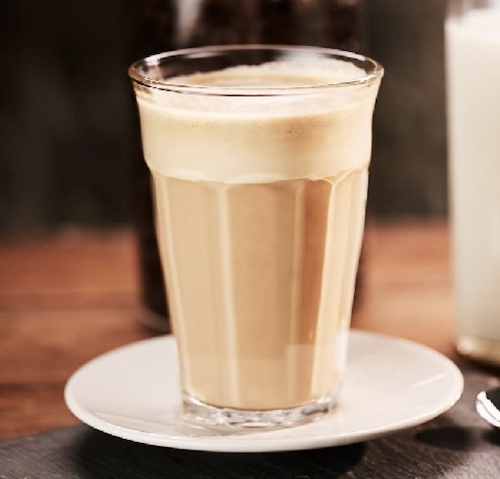Café Manchado is one of Spain’s most popular drinks or types of coffee. It is also one of the most controversial and debated regarding its preparation and proportion of ingredients (milk and coffee). That’s why, being Spanish myself, I think I can clear up your doubts once and for all.
In today’s article, I will explain what Café Manchado is like in Spain, especially in the south. I will also clarify the differences with other coffees and comment on some variants of this very popular Spanish coffee.
What exactly is Café Manchado?
Café Manchado is a mixed drink of coffee and milk, with a higher proportion of milk and less coffee than in a Café con Leche. The Café con Leche contains the same proportion of milk as coffee, while the Café Manchado (also called Leche Manchada) has much more milk than coffee.
The other name that Café Manchado receives helps us to understand the proportions between coffee and milk much better. Leche Manchada means stained milk in Spanish, so we will have a glass of milk, which we stain with a splash of coffee.
It is served in a medium size cup or glass of approximately 110ml, although this depends on the coffee shop’s custom and the client’s taste. If we order it in clear glass, we can appreciate its characteristic light brown colour, almost beige.

Differences between Café Manchado and Café Cortado
Many people get confused between these two types of lattes because of the meaning of their words. Manchado in Spanish means stained, while Cortado means curdles.
- Café Manchado: If we add “Manchado” to the word “café”, we would think that milk stains a black coffee; however, the opposite is true. What we “stain” is the milk with the coffee.
- Café Cortado: On the other hand, when we think of something “curdled”, we associate it with milk, i.e. we add a little coffee to the milk to curdle it. But here, it is also the opposite; the coffee is the one that is curdled with a splash of milk.
To avoid this confusion, the name “Leche Manchada” (stained milk) was born to refer to “Café Manchado” (stained coffee), as here it seems more obvious that we stain the milk with a splash of coffee.
The two main differences between these coffees:
- Manchado is composed mostly of milk, while Cortado is composed mostly of coffee.
- The Machado is served in a medium cup of about 110ml, and the Cortado in a small cup of about 30-45ml.
Is Café Manchado the same as a Macchiato?
A recent article talked about Café Cortado and how it is similar to Espresso Macchiato. Both are composed of an espresso base to which a little milk is added.
Again, the wording confuses us in this case, as the word Macchiato means stained in Italian. So, no, Café Manchado and Macchiato are opposites; The Manchado is mostly milk, and Macchiato is mostly espresso.
Go to a traditional Spanish coffee shop and ask for a Macchiato. They probably don’t know what you’re talking about because, as I said before, in Spain, there are four types of coffee: Café Solo (espresso), Café con Leche, Café Manchado and Café Cortado.
The secrets of Café Manchado: How to make it step by step
The truth is that there is no universal formula or standardised recipe for Café Manchado, as it is usually served in Spanish coffee shops and customised to the consumer’s taste.
If there are no previous indications, a good reference is to pour 85% milk into a medium glass cup or glass and add 15% coffee on top of the milk. Generally, it is served in a medium cup unless it is drunk at breakfast, and the customer asks for it in a large cup.
The milk is usually hot or lukewarm without texturising. However, the customer may specifically ask for it to be served cold, for taste or because he or she is in a hurry and wants to drink the coffee quickly.
In the authentic Café Manchado, the milk is poured into the cup or glass, and the coffee is added according to the customer’s wishes. However, there are places in Spain where it is served the other way around, pouring a little espresso into the cup and then adding a large amount of milk.
There are theories to suit all tastes: some say that if the amount of coffee and milk is the same in both drinks, the taste will also be the same. But some say that by reversing the order, the characteristics of the mixture will be different: it is not the same to serve milk over coffee as it is to serve a little coffee over milk.
